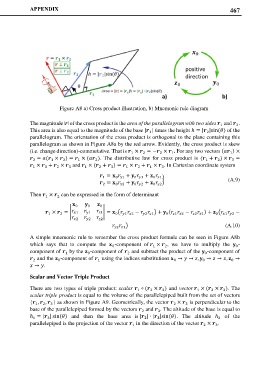Page 487 - Maxwell House
P. 487
APPENDIX 467
a) b)
Figure A8 a) Cross product illustration, b) Mnemonic rule diagram
The magnitude |r| of the cross product is the area of the parallelogram with two sides and .
2
1
This area is also equal to the magnitude of the base | | times the height ℎ = | |sin () of the
2
1
parallelogram. The orientation of the cross product is orthogonal to the plane containing this
parallelogram as shown in Figure A8a by the red arrow. Evidently, the cross product is skew
(i.e. change direction)-commutative. That is × = − × . For any two vectors ( ) ×
1
2
2
1
1
= ( × ) = × ( ). The distributive law for cross product is ( + ) × =
2
2
1
2
2
3
1
1
× + × and × ( + ) = × + × . In Cartesian coordinate system
1
3
2
1
3
2
3
1
2
3
1
= + +
0 1
0 1
1
0 1
� (A.9)
= + +
2 0 2 0 2 0 2
Then × can be expressed in the form of determinant
1
2
0 0 0
× = � 1 1 1� = � − � + ( − ) + � −
0
1 2
2 1
0
1 2
2 1
0
1 2
1
2
2 2 2
� (A.10)
2 1
A simple mnemonic rule to remember the cross product formula can be seen in Figure A8b
which says that to compute the -component of × , we have to multiply the -
1
0
0
2
component of by the -component of and subtract the product of the -component of
0
1
2
0
and the -component of using the indices substitutions → → , → → , →
0
2
0
0
0
1
→ .
Scalar and Vector Triple Product
There are two types of triple product: scalar ∘ ( × ) and vector × ( × ). The
3
2
2
1
1
3
scalar triple product is equal to the volume of the parallelepiped built from the set of vectors
{ , , } as shown in Figure A9. Geometrically, the vector × is perpendicular to the
2
3
2
1
3
base of the parallelepiped formed by the vectors and . The altitude of the base is equal to
3
2
ℎ = | | sin() and then the base area is | | ∙ | |sin(). The altitude ℎ of the
1
2
3
parallelepiped is the projection of the vector in the direction of the vector × .
1
3
2

